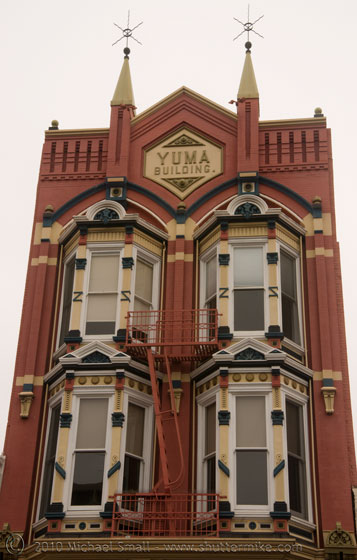No products in the cart.
Landmarks
Hats Off to the Yuma Building
1882 – 188
631 Fifth Avenue
Architects : Armitage and Wilson
Victorian Italianate Revival
When tourists view the stately brick structure with the twin spires that graces Fifth Avenue, their immediate question is, “Why is it called the Yuma Building when it is in San Diego?” The answer is simple – Captain Alfred Henry Wilcox, one of San Diego’s pioneers and the person responsible for the building, had previously been involved with the Colorado Steam Navigation Company and had done extensive steam boating on the Colorado River. Yuma was the first and last stop on the river excursion and Wilcox’s base. Thus – the Yuma Building.
Captain Wilcox originally came to San Diego in1849 as a mate on the U.S. Invincible. He later returned as the ship’s captain, charged with the task of surveying the San Diego River, and ultimately constructing a dam in an effort to turn part of the river into a “False Bay.” (now Mission Bay). In 1863, he married Maria Antonia Arguello, daughter of a wealthy landowner, and the Wilcox family made their home at “La Punta,” the southeast corner of San Diego Bay. They later moved to Alonzo Horton’s New Town, where they built a mansion at 1309 Second Street. It later became the Belle View Apartments.
Wilcox was involved in numerous commercial ventures in San Diego. He contracted to supply water to the city, incorporate the San Diego Daily Bulletin, was a trustee of the San Diego Publishing Company, and later became an original stockholder and president of the Commercial Bank of San Diego. He, additionally, had banking interests in Los Angeles and San Francisco.
One year prior to his death in 1883, Captain Wilcox began construction on the north half of Lot D, Block 094/871, which he had acquired from Edward W. Tebbutt. The lot was originally sold by Alonzo Horton to Frank Caillard, who quickly sold the north half of the lot to Mr. E.W. Tebbutt. In 1877, Tebbutt sold this and other properties to Wilcox for $ 1345.00. On April 4, 1882, construction began on what was described as a substantial brick building, which was to be furnished with all the latest improvements – gas and water fixtures and large drainage pipes. The building is one of the first structures in San Diego to be built entirely of bricks. The original building was one story with a frame porch in front.

As Captain Wilcox died the following year, the building was not expanded until 1885 when his estate was finally settled. At his death, the. estate was valued at $644,000, which included real estate throughout California and stock in railroad companies and other companies. Mrs. Wilcox inherited the building, and after suing the estate trustees for their 1/4 interest in the Wilcox holdings, she began construction on the building as it stands today.
The Yuma Building, a classic example of Victorian architecture, is three stories high with a basement. The street level walls are 16″ thick and the walls on the second and third floors are 12″ thick. The front was iron-clad and featured bay windows. A large skylight lighted the upper two stories. The structure contained 16 rooms and a store on the ground level. A lovely stairway graced the northwest corner. The basement was used for storage and cellars.
Throughout the years, a variety of businesses occupied the building including a Japanese Bazaar, medical offices, an insurance broker and a dry goods store. In 1901, the upper floors were converted to furnished rooms, and were operated as the “Santa Isabel.” In 1910, the rooms became known as “The Grant.
On November 11, 1912 the Grant gained notoriety for becoming the first stop of the Great Raid of 1912. As the California- Panama Exposition was coming to San Diego in 1915, Police Chief Keno Wilson was receiving increasing pressure from several civic minded organizations, including the Ladies’ Purity League, to clean up the Stingaree, as the area was called. Due to the transient nature of much of the clientele, many who were sailors on ships stopping at the foot of Fifth Avenue, the Stingaree had become famous for its numerous saloons and accompanying brothels. Early on a Sunday morning, the raid began, and by the end of the day, Keno Wilson had rounded up 138 ladies of the evening. Chief Wilson gave them a choice – either reform or get out of town. The city would pay for their train ticket. Only two decided to reform. One became a telegraph operator and the other went insane, likely as a result of a social disease. The other ladies were marched up Fifth Avenue to the Santa Fe Depot, where they were instructed to purchase tickets. Unfortunately, they did not receive complete instructions, as most of them purchased round-trip tickets and returned the next day!

The property remained a single room occupancy hotel until 1989 when it came on the market. It was purchased by Marsha Sewell, an interior designer, and her late husband, Mike Shea, an airline pilot, who both had a passion for real estate. The building was in poor condition, and a major restoration effort was in order. In 1992, Marsha, a former GQHF board member, moved her office into the basement, which she described as “perfect for me.” The first floor was carefully restored, and is believed to be the only ground level store with an intact original interior. The tenant is Goorin Bros. Hats, a Victorian hat shoppe.
The upper two floors, a two-story showplace townhouse, were completed in 1992, and Marsha lived in the house until 2003, after Mike’s passing in 2001. This exquisitely restored home, complete with four fireplaces, has been the site of many cultural and civic events , and has hosted numerous dignitaries. Its stately presence continues to grace the Gaslamp.

Sandee Wilhoit is the historian for the Gaslamp Quarter Historical Foundation. She can be reached at [email protected].

